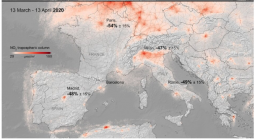Pollutionwatch: why has particle pollution increased under lockdown?

Air pollution from traffic has dropped but particles also come from gas heating and agriculture.
News reports have focused on reductions in air pollution from traffic during the lockdown, but particle pollution has increased in the last few weeks.
At the end of March, and again around Easter, UK particle pollution reached its greatest concentrations for the year so far. This peaked across south-east England on 9 April, at eight on the 10-point UK air quality index.
Values between four and six were measured over most of England and Wales. Spring smogs happen most years and typically result in air pollution at index eight to 10. So, the lockdown may have averted the worst impacts but why are we having any air pollution at all?
Chemical analysis by King’s College London reveals that the particles came from traffic and industry, gas heating and agriculture. The annual start to the agriculture cycle makes spring the most polluted time of year in western Europe. A global study showed that halving ammonia from farming could reduce the early deaths from air pollution in Europe by around 20%. This could be done by improving fertiliser spreading (also saving farmers money), changing animal feeds and better manure and slurry storage. Home wood burning was measured during the March episode but had less impact in the warmer weather around Easter.
23 April 2020
The Guardian





